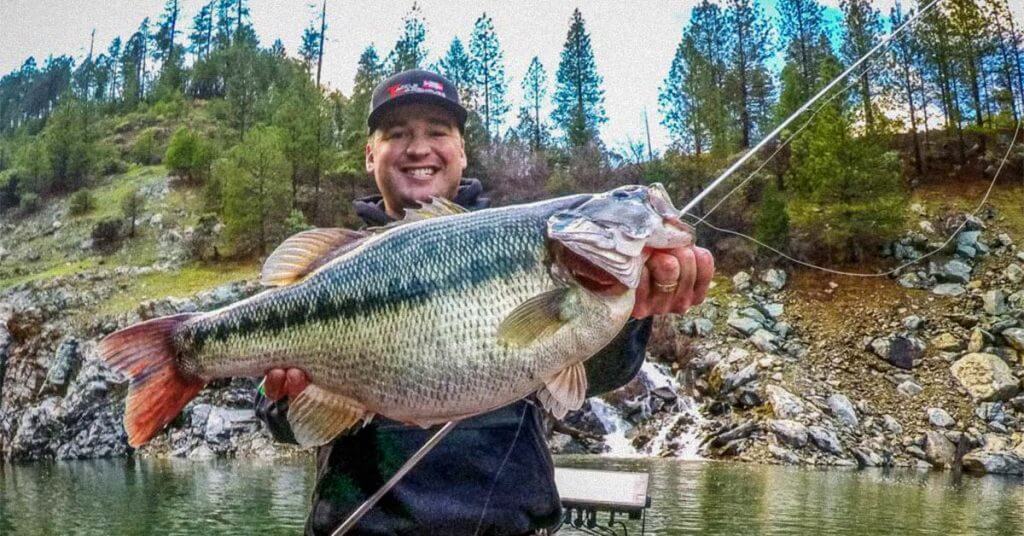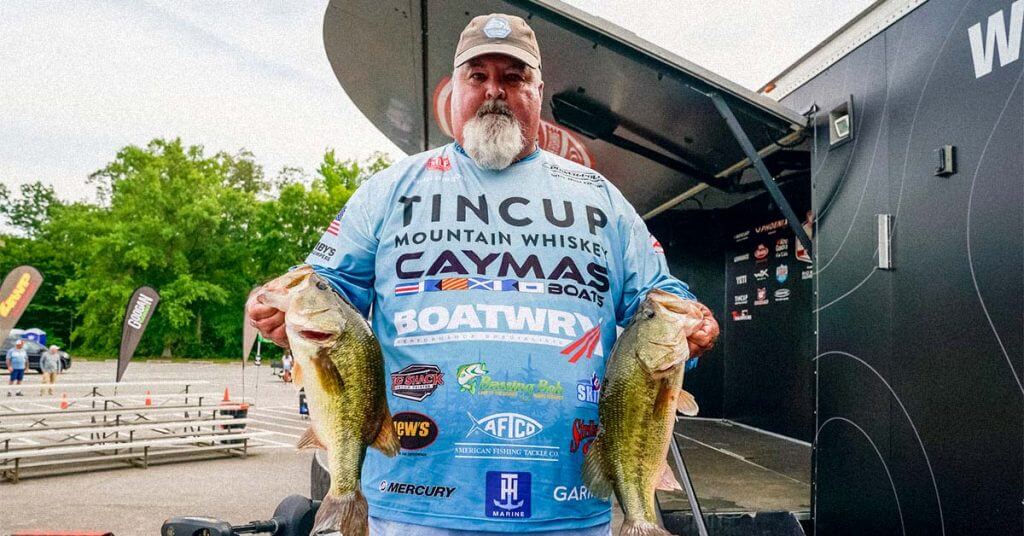
Long before Jimmy Houston became nationally known for his shaggy blond hair, his sunglasses, his excited giggle and his penchant for kissing the bass he caught, he was a struggling college graduate searching for a way to set himself apart.
He ran an insurance agency in Oklahoma at the time. But it’s what happened in the backroom that put him on the path to fishing fame.
He and his wife Chris fashioned homemade spinnerbaits that were revolutionary at the time.
Those Redman spinnerbaits were built from safety pins, with a jig head and a living rubber skirt on one end and a big Colorado blade on the other.
Houston usd his baits to catch many fish in his home state of Oklahoma ,and he soon branched out to win tournaments in neighboring states as well.
Little did he know that his prowess with spinnerbaits would launch a legendary career that included two Angler of the Year titles in B.A.S.S., hosting a longstanding television show, authoring several books tying fishing to his Christian faith, and a reputation as one of America’s most revered fishermen.
“During the seasons when I won Angler of the Year, probably 70 percent of the bass I caught were on a spinnerbait,” Houston said. “And those were 10 years apart (1976 and 1986).
“It’s just a bait that is so versatile. If you can cast accurately, you can catch fish on a spinnerbait.”
Looking for some tips? Houston will cast plenty our way in this column.
So, tie on a spinnerbait and hop into the boat. We’re going fishing for the big ones.
Table of Contents

One of Jimmy Houston’s first Redman spinnerbaits, still in its package (courtesy of Jimmy Houston)
A Bait for the Ages
From the start, Jimmy Houston knew how to promote.
His catch phrase for his Redman spinnerbaits –“A Bait So Good It Ought To be Illegal”–was designed to lure fishermen as well as fish.
It worked. When Houston started catching bass on the lures he designed, he went to work to get the word out.
“I went to Sam Walton (of Walmart fame) when he had only 13 stores and told him I had fished all the lakes around his stores with this bait and I had caught a lot of big fish,” Houston recalled.
“I told him I knew the right colors for those lakes and that they would sell like crazy because they catch fish.
“He took me up on it and he sold a lot of baits.”
So what made the bait so effective? Many spinnerbaits at the time used just strips of rubber bands as skirts. But Houston went one step further.
He bought living rubber skirts from other companies, then he attached them to molded jig heads.
He used safety pins for the main frame of the bait, and featured a long arm that vibrated back and forth when retrieved. Then he attached a swivel and a big Colorado blade to get plenty of “thump.”
That allowed for a slow retrieve that put off plenty of vibration.
The name came from the nickname of the college he attended, Northeastern State University in Oklahoma. The school’s athletic teams were known as the Redmen.
Administrators later decided to rename the school’s nickname to the River Hawks in deference to social pressures.
But even when Luck-E-Strike brought the Redman back, Houston and company officials decided to stay with the original name.
“In my eyes, there is nothing derogatory about the name,” Houston said. “I am married to an Indian, and I’m proud of that. And the owner of Luck-E-Strike at the time was a Choctaw Indian and he was proud of his heritage.
“I told him we might get hammered by some people who think the name is (socially unacceptable). But I also told him it’s OK if they got mad at us, because the people who would get upset don’t buy spinnerbaits anyway.”
Insert that famous Houston cackle.
Now that country music legend Toby Keith has purchased Luck-E-Strike, the Redman spinnerbait will be one of the featured items.And Houston is convinced they will still catch fish.
“The fish today haven’t seen this spinnerbait,” he said. “Until recently, it had been out of production for a long time.
“So it’s almost like a new bait.”
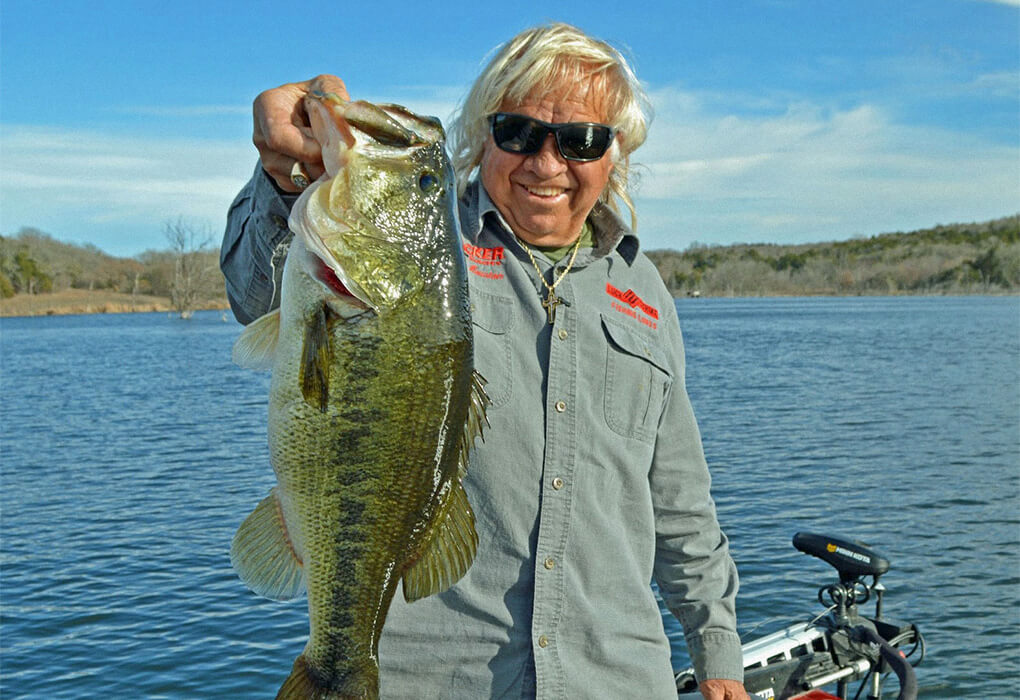
Jimmy Houston catches big bass on spinnerbaits (courtesy of Jimmy Houston Outdoors)
The Art of Fishing With Spinnerbaits
So you think there is nothing more to fishing a spinnerbait than “chunkin’ and windin’’ ”’?
Well, you have it all wrong, Houston said.
“You don’t ever want to just throw it out and crank it back in,” Houston said. “You have to do something to give it action all the time.
“Maybe it’s holding your rod high so that spinnerbait is just coming across the surface, or maybe it’s pointing the rod down so it gets a little depth. Maybe it’s getting to act a little erratic, or pumping it so it rises and then falls.
“You never want to get in the habit of just reeling it back in.”
Casting accuracy is another key. Houston grew up living on Lake Tenkiller in Oklahoma, where his dad owned a resort. He had his own boat at a young age and was on the water constantly.
He remembers a time during his high-school years when the nation’s best bass fishermen visited the lake to compete in the World Series of Sport Fishing.
“I took some of the pros fishing during practice and I was amazed at how far they could throw and how accurate they were,” Houston said.
That convinced Houston even more about how important it was to be able to cast accurately. He is proud of the fact that he has only lost one casting tournament over the years (“And that was to someone who was just faster than I was,” he said.)
Blade size also plays a part.
“Large blades will create more flash, more vibration,” Houston said. “But they’re harder to throw with accuracy, especially in the wind. They’re good, especially when the water is murky.
“In clearer water, you want to go to a lower, profile bait. After the spawn and there are a lot of tiny, tiny baitfish in the water, bass don’t hit the way they usually do.
“They might just swim through a school of those fry with their mouths open, just slurping them in.”
So, what are you trying to imitate when you use a spinnerbait? Good question, Houston said.
“I have no earthly idea what they think that spinnerbait is,” Houston said. “The color, vibration and action is what they react to.
“Sometimes I think they see it and think, ‘That thing is going to ruin the neighborhood. We have to kill it so that it doesn’t get established in this lake.’ ”
Again, that famous cackle.
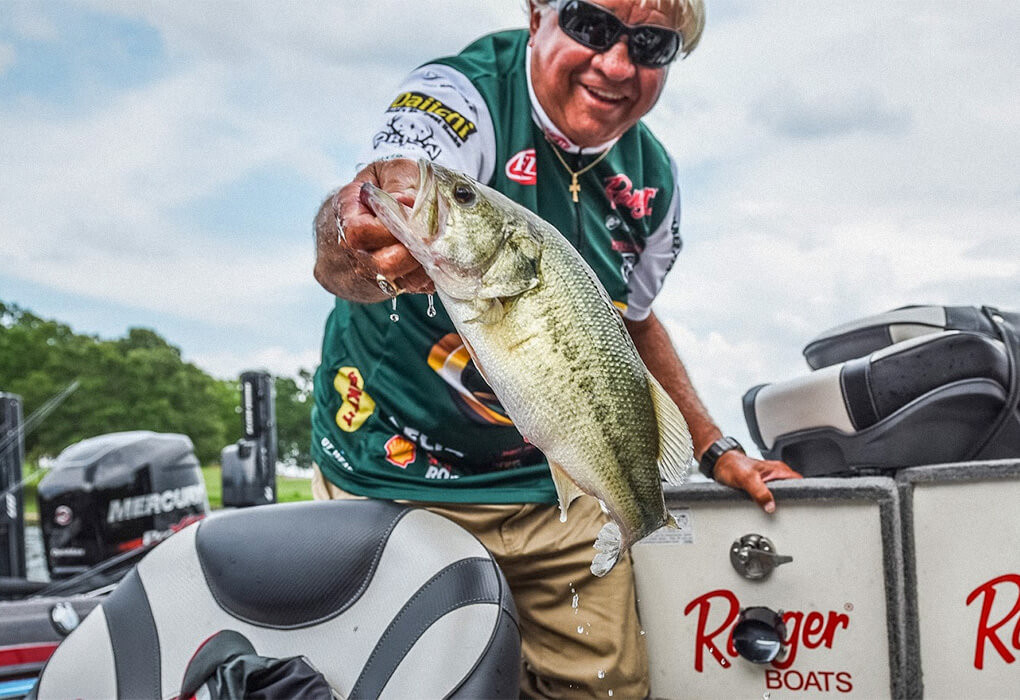
Jimmy Houston showed off one of the bass he caught during an FLW tournament (photo by Charles Waldorf/Major League Fishing)
What Depth?
The spinnerbait is generally thought of as a shallow-water bait, but there are exceptions.
The biggest bass Houston has caught on the bait weighed 12 pounds, 7 ounces and hit when he was slow-rolling the lure over a rock pile in 20 feet of water.
“Generally, the way I like to fish a spinnerbait is down just far enough so I can barely see it,” he said. “But I’ve caught a lot of bass waking it across the surface, too.”
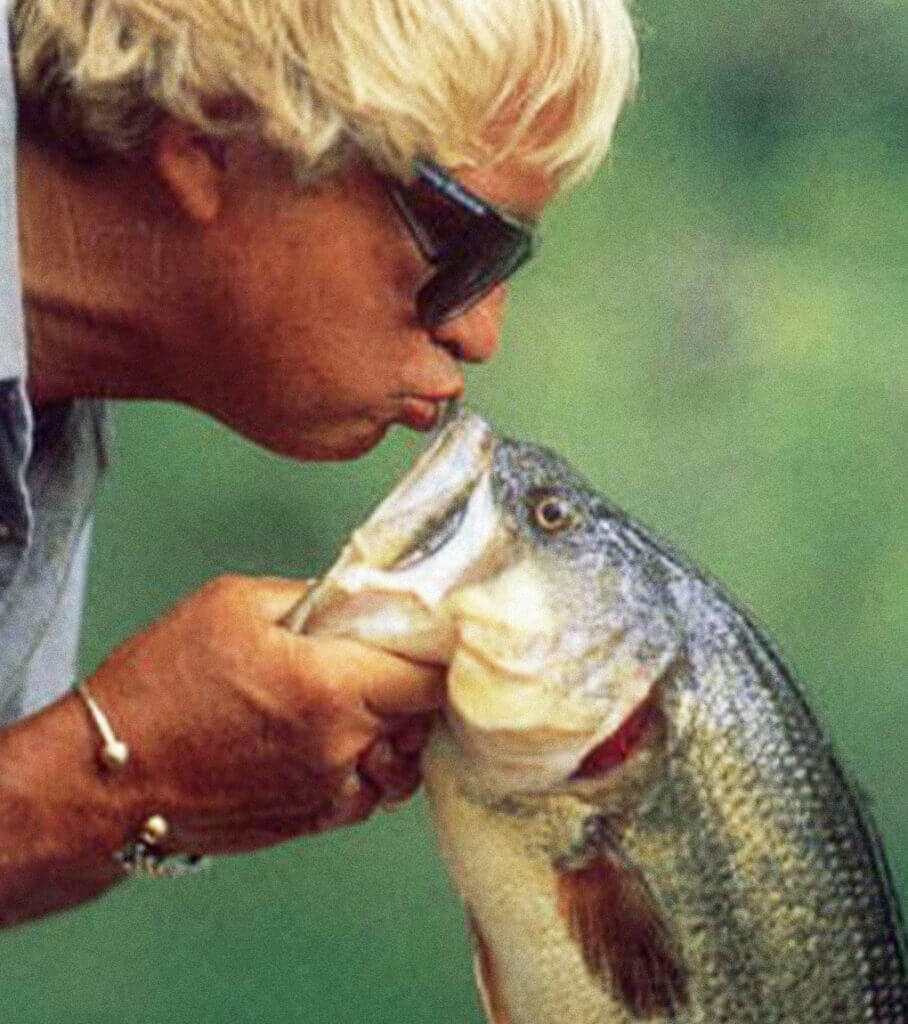
Jimmy Houston has inspired many fishermen to kiss the bass they catch for good luck (courtesy of Jimmy Houston Outdoors)
A Good-Luck Kiss
Houston gets dozens of emails or Facebook posts each season from fans showing them kissing their catch before they plunk them back into the water.
He inspired that trend years ago when he smooched a bass in an expression of gratitude.
“I’m not even sure when I did it for the first time,” he said. “It might have been when I caught a big fish in a tournament. Either that, or when we were filming a TV show and I caught a big fish that we like to use for a closing.
“All I know is that we have the whole world kissing fish. Someone even sent me a picture of Vladimir Putin kissing a fish.”
Houston paused and added, “I think the fish kind of like it when I kiss them. They know I always let them go.”

Jimmy Houston knows that there are shortcuts to locating big bass (courtesy of Jimmy Houston Outdoors)
Dare to be Different
So you get a tip and someone tells you that the locals are catching big fish on fire tiger-colored crankbaits. Is that what you should throw?
Not really, Houston said.
“It’s vital on lakes that get a lot of fishing pressure to give the fish something different than what they are used to seeing,” Houston said.
“There have been a lot of lures that were hot for a while that just faded away because so many people were using them.
“Whenever possible, give the bass something different than what everybody else is using.
The lure industry is constantly trying to come up with something the fish haven’t seen before–different colors, different action, different sounds.
“That’s why some of these new or retro baits will work so well for a while.”
Also, look for cover that is different from its surroundings.
“If you have an area that has a bunch of stumps and only a few logs, the bass will most likely be on those logs,” Houston said.
“If you have a cove that has 40 boat docks in it, the fish might be on some of them. But I would much rather start in a pocket that only has one boat dock.
“That narrows it down.”
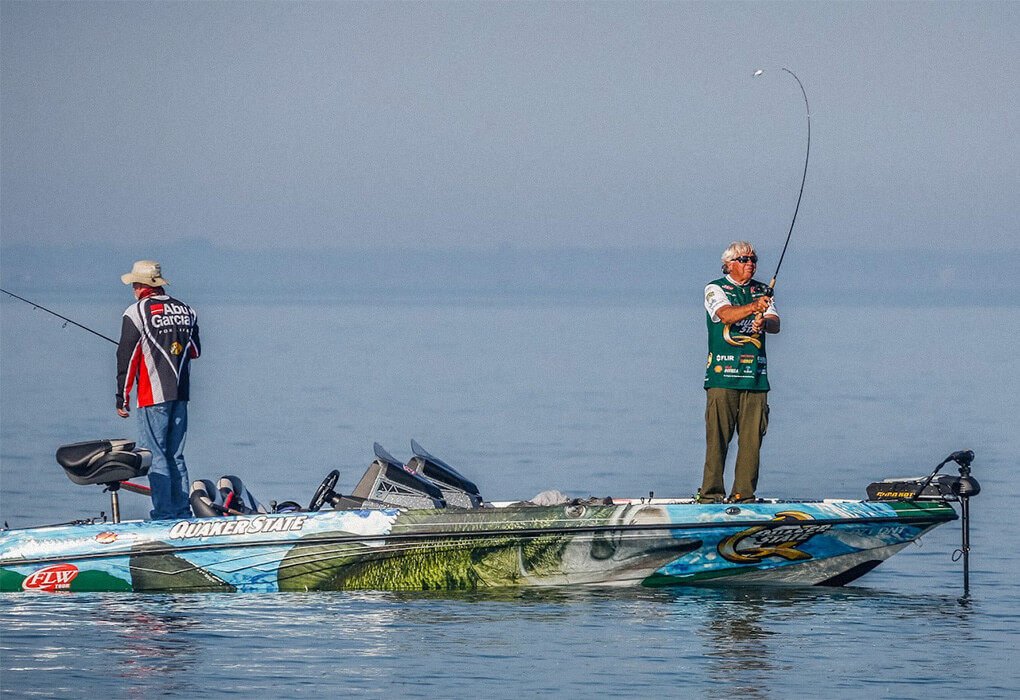
Advanced electronics have sped the learning curve for many anglers, according to fishing legend Jimmy Houston (photo by Sean Ostruszka/Major League Fishing)
Destroying Fishing Myths
Houston laughs when he recalls the way many fishermen fished a plastic worm years ago.
“We fished plastic worms on a jig head and we thought they had to be colored like an earthworm,” he said. “We thought they would hit the tail first and then work their way up to the head.
We would hit the button on our reel when we got a hit and feed out line. We’d let that bass have it for 20 to 30 seconds before we would set the hook.
“In reality, that fish had it in his mouth the whole time. A lot of bass swallowed the hook as a result.”
Forward-facing sonar, the electronic device that shows real-time movement of fish, has dispelled other longtime beliefs. For many years, bass fishermen pounded the banks and seldom chased open-water fish.
But the sonar units show how many bass will suspend on the main lake, and how it takes good casts to get them to hit.
“We’ve seen how far a bass will travel to hit a bait in clear water,” Houston said. “When we would mark a fish in the past, we thought we would have to bring our lure right above them.
“But with all the pressure on the main lake now, I think some bass are getting lure-shy. We have to make longer casts and move them from longer distances.”
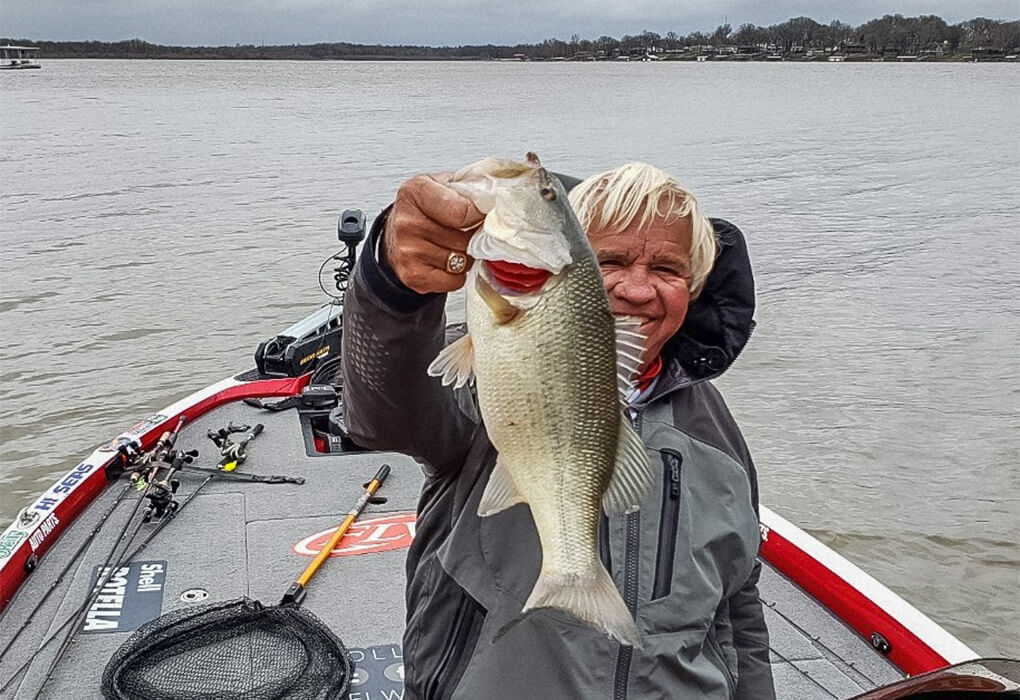
Last Cast
At age 79, Houston still has plenty of energy. Though he no longer fishes tournaments, he still is busy taping his “Jimmy Houston Outdoors” television show, providing daily fishing tips and regular devotionals on line.
He credits his Christian faith with helping him stay humble during the good times and comforting him during the bad times.
His life was rocked when his longtime wife and fishing partner Chris suffered a debilitating stroke two years ago. She is still recovering, though it hasn’t been easy.
Bass fishing remains a refuge for Houston and he still finds joy in catching a big bass on a spinnerbait.
So what has he taught us? Spinnerbaits are far more versatile than most fishermen think.
Combine accurate casts, an ability to put some “action” into your retrieves, and hitting spots that are different from their surroundings, and you too will be able to improve your fishing.

